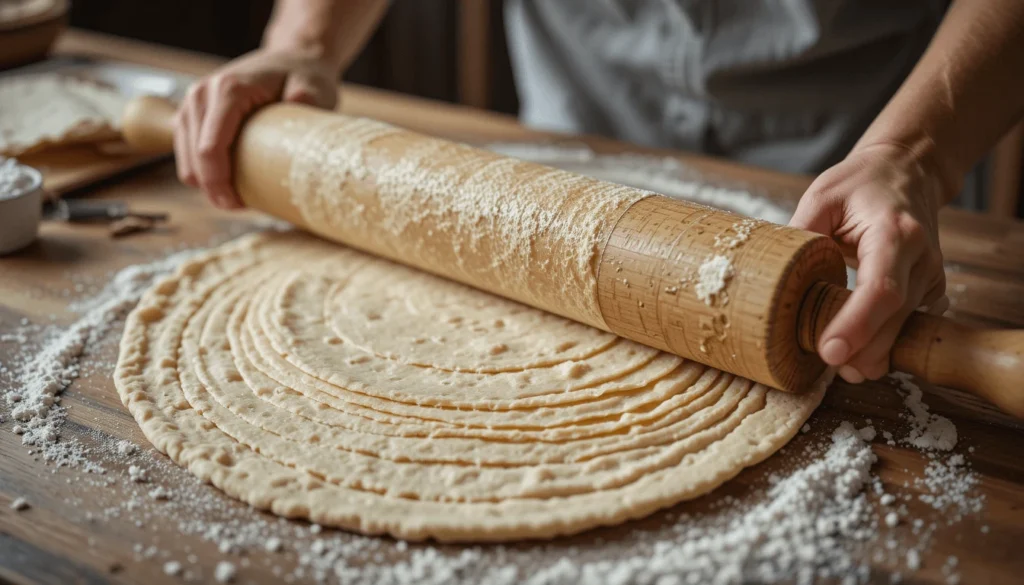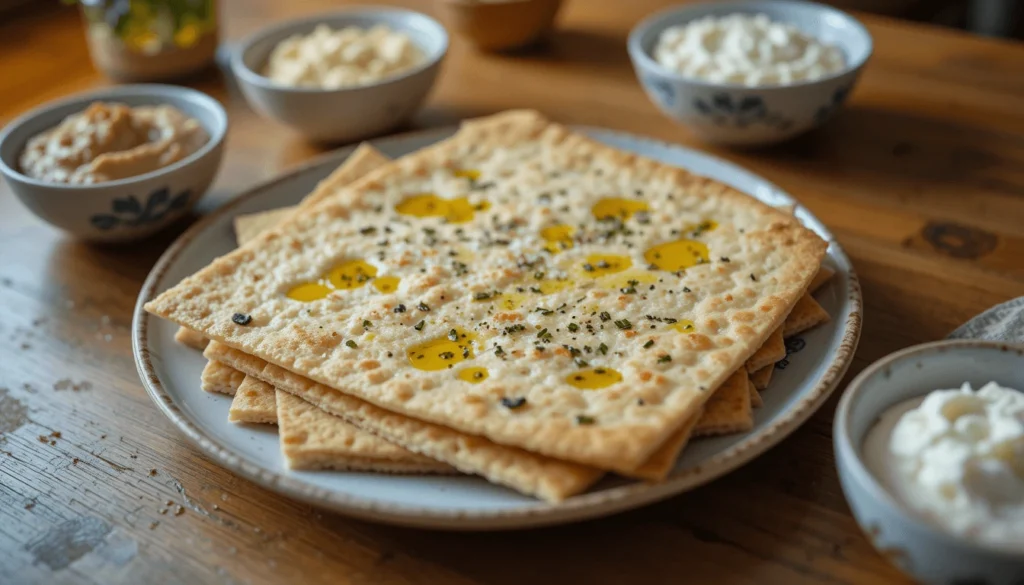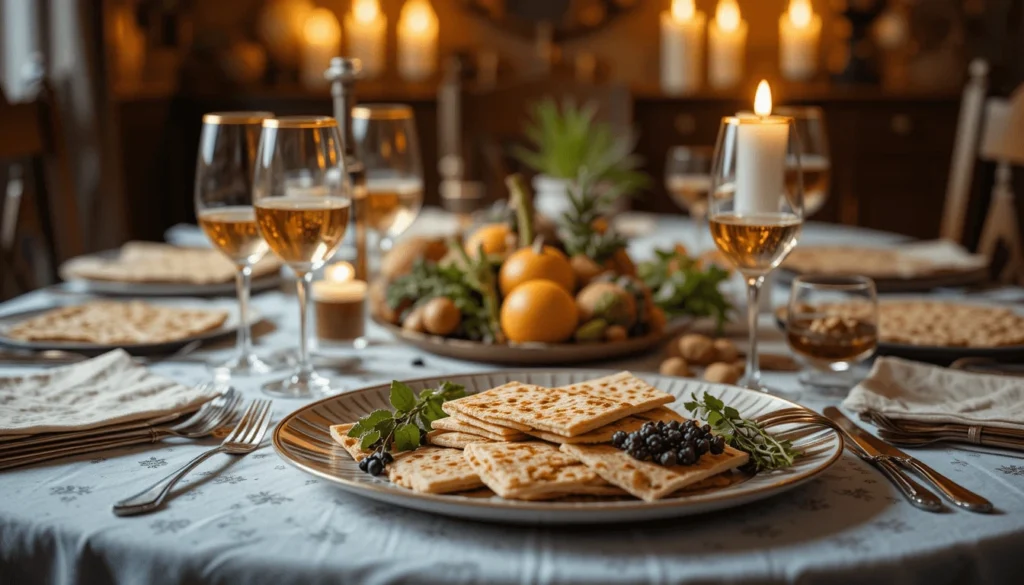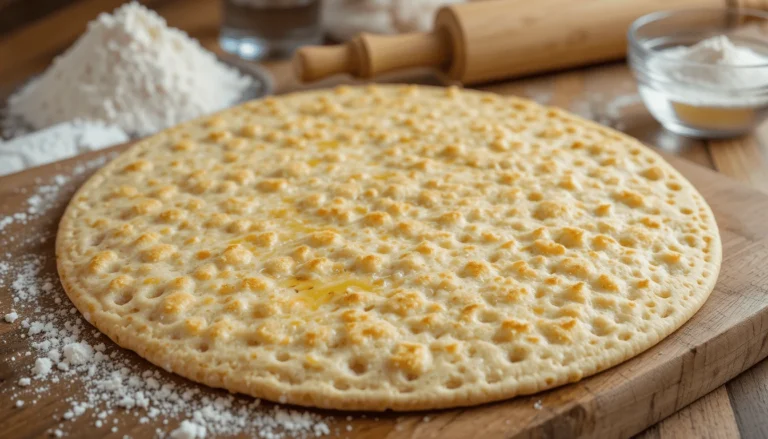What is Matzah?
Understanding Matzah’s Role in Passover
Unleavened bread is a symbolic unleavened bread traditionally eaten during Passover. It represents the bread the Israelites baked as they fled Egypt, unable to wait for it to rise. Its significance lies not just in tradition but also in the celebration of freedom, highlighting the hurried departure from Egypt. Passover bread is an essential part of the Jewish faith and a centerpiece of the Passover Seder meal, allowing participants to engage with the symbolism of freedom and hardship.
Key Ingredients for Making Matzah
To create authentic Passover bread only two ingredients are required: flour and water. The simplicity of these ingredients underscores the quickness with which the Israelites had to prepare their food in their flight from slavery. For kosher Passover bread, special Passover flour is used, ensuring it hasn’t come into contact with moisture or leavening agents before baking. This flour is often prepared in a way that complies with the strict rules of Jewish dietary laws for the holiday.
Table of Contents
Table of Contents
Key Ingredients for Making Matzah
| Ingredient | Quantity | Purpose |
|---|---|---|
| Flour | 1 cup | The base of the dough |
| Water | 1 tablespoon | To form the dough |
| Olive Oil | Optional | For brushing after baking |
| Salt | Optional | For seasoning |
The History of Matzah
Unleavened bread Historical Significance in Judaism
Passover bread is deeply rooted in Jewish history, directly tied to the Exodus, when the Israelites fled Egypt in a hurry. The bread they baked during their flight didn’t have time to rise, creating the traditional unleavened bread that we now call matzah. For over 3,000 years, Jews have commemorated this moment by eating Passover bread during Passover, ensuring the story of freedom is remembered in every generation.
How Matzah Became a Symbol of Freedom
Passover bread is more than just food; it’s a symbol of liberation. The act of eating unleavened bread during Passover connects Jewish people to the hardships their ancestors endured. It serves as a reminder of the struggle for freedom and the transition from slavery to redemption, reinforcing the importance of remembering one’s history.
Unleavened bread Historical Significance in Judaism
| Key Event | Description | Symbolism |
|---|---|---|
| Exodus from Egypt | Israelites fled Egypt in a hurry, without waiting for the bread to rise | Freedom and haste |
| The Giving of the Torah | The bread became a symbol during Passover as part of the Seder meal | Reminder of hardship and redemption |
Step-by-Step Guide to Making Matzah

Preparing the Dough: Flour and Water
The process of making matzah begins with simple ingredients: flour and water. Mix them quickly into a dough, ensuring it doesn’t rest too long—this is critical for making kosherPassover bread. According to Jewish law, the dough must be mixed and baked within 18 minutes to ensure it doesn’t ferment, which is why speed is so crucial in this process.
Rolling and Shaping the Matzah
Once your dough is prepared, it’s divided into small pieces, which are rolled out into thin discs. It’s important to roll the dough thinly, as the thinner it is, the crispier the final product will be. After rolling out the dough, you should pierce each piece multiple times to ensure it doesn’t puff up during baking.
Baking the Matzah to Perfection
Passover bread is baked in a very hot oven, usually at around 475°F (245°C). The dough is placed on a preheated baking sheet and baked for a few minutes on each side. The key is to flip the Passover breadquickly, ensuring it becomes golden and crisp. Keep a close eye on the Passover bread as it bakes to ensure it doesn’t overcook or burn.
Baking Time and Temperature
| Step | Time (Minutes) | Temperature (°F) |
|---|---|---|
| Preheat oven | 10 minutes | 475°F |
| Bake the first side | 2 minutes | 475°F |
| Flip and bake the second side | 2 minutes | 475°F |
Kosher Matzah: A Special Tradition
What Makes Matzah Kosher for Passover?
To make Passover bread kosher for Passover, it must adhere to strict rules set by Jewish dietary laws. This includes using Passover flour and ensuring the dough is mixed and baked within 18 minutes. The kitchen and utensils used to make the Passover bread should also be kosher for Passover, free from any chametz (leavened products). These rules ensure that the bread is truly unleavened, just as it was when the Israelites fled Egypt.
Timing and Ingredients for Kosher Matzah
The timing of preparation is crucial to making kosher Passover bread. The flour and water must be combined and baked within 18 minutes to prevent fermentation and ensure the Passover bread remains unleavened. Special Passover flour is used, and the dough is worked quickly, with no delays allowed.
Tips for Perfect Matzah Every Time

The Right Texture: Thin but Not Too Fragile
The best Passover bread is crisp but not so fragile that it falls apart at the slightest touch. When rolling out the dough, aim for a thin, even layer. Don’t be afraid to roll it thinly—this ensures the unleavened bread is crunchy and perfect for serving during the Seder meal.
Avoiding Common Matzah Mistakes
One common mistake is rolling the dough too thick, which can result in soft, chewy Passover bread. Ensure you knead the dough well and roll it evenly. Another issue is underbaking the matzah, which results in a less crispy texture. Always bake the Passover bread until it turns a light golden brown to ensure the best texture.
Common Matzah Mistakes to Avoid
| Mistake | Consequence | How to Avoid it |
|---|---|---|
| Not rolling the dough thin enough | The matzah becomes soft, not crispy | Roll the dough as thin as possible, ensuring uniform thickness |
| Baking for too little time | Matzah remains chewy and undercooked | Bake for the recommended 4 minutes, flipping once for even baking |
| Overbaking | Matzah burns and becomes too brittle | Keep a close eye during baking, checking often |
Flavors and Seasonings for Your Matzah
Traditional Olive Oil and Salt Topping
The classic way to enhance the flavor of matzah is by brushing it with olive oil and sprinkling it with salt. This brings out the bread’s flavor and adds a satisfying, savory touch. Olive oil also gives the unleavened bread a slight gloss, making it look even more appealing on the Seder plate.
How to Add Unique Flavors to Matzah
For a twist on traditional matzah, consider adding other seasonings like garlic powder, thyme, or even a light drizzle of honey for sweetness. These variations allow you to tailor the Passover bread to your taste, adding an extra layer of flavor to the unleavened bread.
Flavors You Can Add to Matzah
| Topping | Purpose |
|---|---|
| Olive Oil | Adds richness and helps seasonings stick |
| Salt | Traditional seasoning, enhancing flavor |
| Garlic Powder | Adds savory depth |
| Cinnamon | For a sweet twist, especially for dessert matzah |
Serving Suggestions for Matzah

Matzah as a Snack: Perfect with Dips and Spreads
https://www.allrecipes.com/recipe/213682/matzah/
unleavened breadisn’t just for Passover meals; it can be enjoyed year-round as a snack. Pair it with spreads like hummus, cream cheese, or even guacamole for a satisfying treat. Its neutral flavor makes it versatile, ready to be combined with a variety of toppings.
Using for Matzah Brei or Other Recipes
unleavened bread brei is a popular dish made by frying broken pieces of Passover bread with eggs, sometimes with sweet or savory additions. You can also use Passover bread in soups, casseroles, or even for breading. The possibilities are endless when it comes to cooking with matzah, making it a versatile food for many dishes.
Storing Matzah and Keeping It Fresh
How to StoreforTraditional bread Maximum Freshness
To keep your Passover breadfresh, store it in an airtight container. You can keep it at room temperature for up to a week, but if you want it to last longer, refrigeration is your best bet. Proper storage will prevent it from becoming stale too quickly.
Freezing Flatbread: Tips for Long-Term Storage
Freezing is another great option for long-term storage. Wrap the Passover bread tightly in plastic wrap and foil before freezing. When you’re ready to eat it, simply thaw it at room temperature or bake it again for a fresh, crisp texture.
FAQs about Matzah

1. How Long Does It Take to Make Matzah?
It typically takes around 20 minutes to make Passover bread, including mixing, rolling, and baking. If you’re preparing kosherPassover bread, the dough must be mixed and baked within 18 minutes to meet religious requirements.
2. Can You Make Matzah Without Special Flour?
Yes, you can make Passover bread with regular flour. However, if you want to make it kosher for Passover, you’ll need to use Passover flour, which is specifically prepared for this purpose.
3. How Can I Make Matzah More Flavorful?
You can enhance the flavor of Passover bread by brushing it with olive oil, sprinkling it with salt, or adding herbs and spices like garlic powder, thyme, or cinnamon.
FAQ – How Long Does It Take to Make Matzah?
| Stage | Time (Minutes) |
|---|---|
| Mixing dough | 2-3 minutes |
| Rolling and shaping dough | 5 minutes |
| Baking | 4 minutes |
| Total Time | 10-12 minutes |
Conclusion:
Matzah is much more than just a bread; it carries deep cultural, religious, and historical significance. Whether you’re making Passover bread for the first time or refining your technique, following the steps carefully ensures you get a delicious and symbolic unleavened bread that honors tradition. From preparing the dough to baking it to perfection, you now have all the tools needed to create your own Passover bread at home, adding a special touch to your Passover celebration.
Remember, the process of makingPassover breadis a connection to the past, bringing the story of freedom and the journey of the Israelites to life in your kitchen. As you enjoy this crispy, flavorful bread, you’re not just indulging in a traditional recipe; you’re participating in a tradition that’s been passed down for thousands of years.
So, whether you’re serving it at your Seder, using it for Passover bread brei, or just snacking on it with your favorite spreads, making Flatbread from scratch is an enjoyable and meaningful experience. Happy baking and chag sameach (happy holidays)!
Print
Matzah Recipe – The Best Way to Make Matzah for Passover
Learn how to make traditional matzah from scratch with this simple, step-by-step recipe. Matzah, the unleavened bread eaten during Passover, is easy to prepare with just a few basic ingredients: flour and water. Whether you’re looking to make kosher matzah for your Seder meal or just want to enjoy this crispy flatbread, this recipe ensures you get the perfect texture every time. You can customize your matzah by brushing it with olive oil and sprinkling it with salt, making it a delightful treat for any occasion. Enjoy this timeless Passover bread that symbolizes freedom and tradition.
- Total Time: 20 minutes
- Yield: 8 pieces of matzah 1x
Ingredients
1 cup flour (kosher for Passover flour, if needed)
1/3 cup water (or as needed)
1 tablespoon olive oil (optional, for brushing)
Salt (to taste)
1 teaspoon flour (for rolling)
Instructions
Preheat the oven to 475°F (245°C).
Dust a clean work surface and rolling pin with 1 teaspoon of flour.
Place 1 cup of flour into a mixing bowl. Gradually add water, one tablespoon at a time, stirring with a fork until the dough forms a rough ball.
Transfer the dough to the prepared work surface and knead rapidly for 30 seconds to 1 minute until smooth.
Divide the dough into 4 equal-sized pieces, then roll each into a ball.
Roll each dough ball out into a thin disc, about 8 inches in diameter. Make sure it’s very thin, and pierce the dough with a fork at least 25 times on each side to prevent rising.
Place the rolled dough onto a preheated baking sheet and bake for about 2 minutes. Flip and bake for an additional 2 minutes until light brown and crispy.
Brush lightly with olive oil and sprinkle with salt to taste.
Let the matzah cool on a wire rack before serving.
Notes
Kosher for Passover: If you’re making this recipe for Passover, be sure to use kosher flour that has been specially prepared for the holiday. The flour should not come into contact with moisture before use.
Timing is Crucial: When making kosher matzah, the entire process (from mixing the flour and water to baking) must be completed within 18 minutes to ensure it remains unleavened. This is a key requirement in the preparation of Passover bread.
Gluten-Free Option: If you need a gluten-free version of matzah, you can substitute the flour with gluten-free flour. Be sure to check the label for Passover certification if needed.
Storage: Matzah can be stored in an airtight container for up to a week at room temperature. For longer storage, you can freeze it for up to a month. Just make sure to wrap it well in plastic and foil to prevent freezer burn.
Flavor Variations: While traditional matzah is served with just olive oil and salt, feel free to get creative! You can add other seasonings like garlic powder, cinnamon, or even a drizzle of honey for a sweet twist.
- Prep Time: 15 minutes
- Cook Time: 5 minutes
- Category: Bread, Passover Recipes
- Method: Baking
- Cuisine: Jewish
- Diet: Gluten Free
Keywords: matzah, Passover bread, unleavened bread, homemade matzah, kosher matzah, traditional Passover bread, matzah recipe


